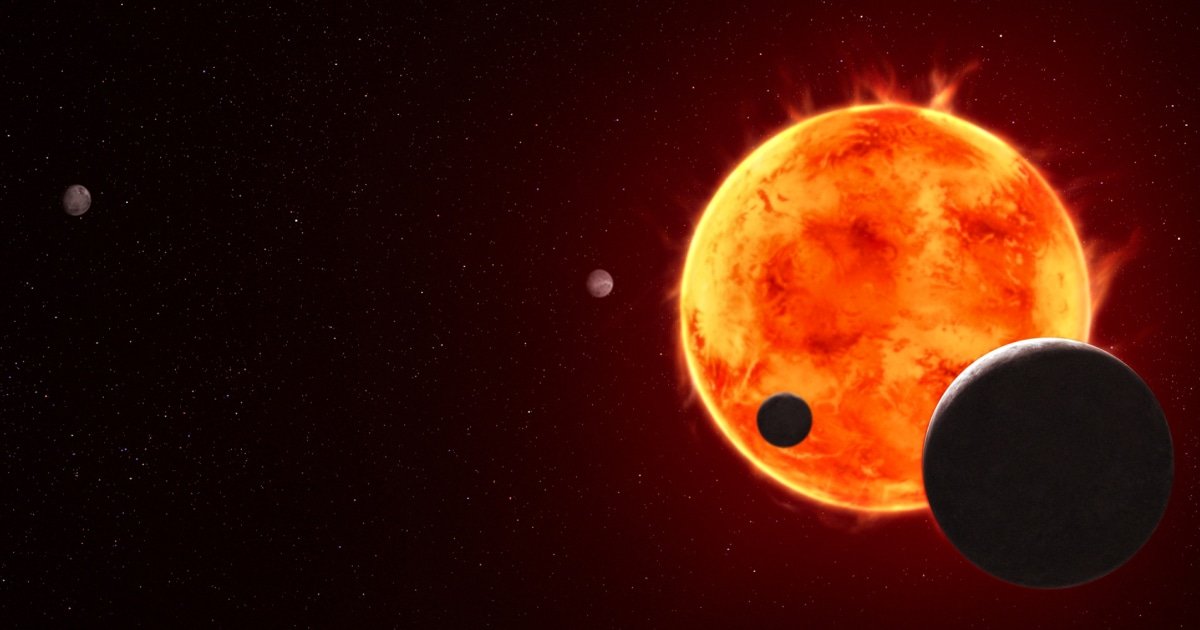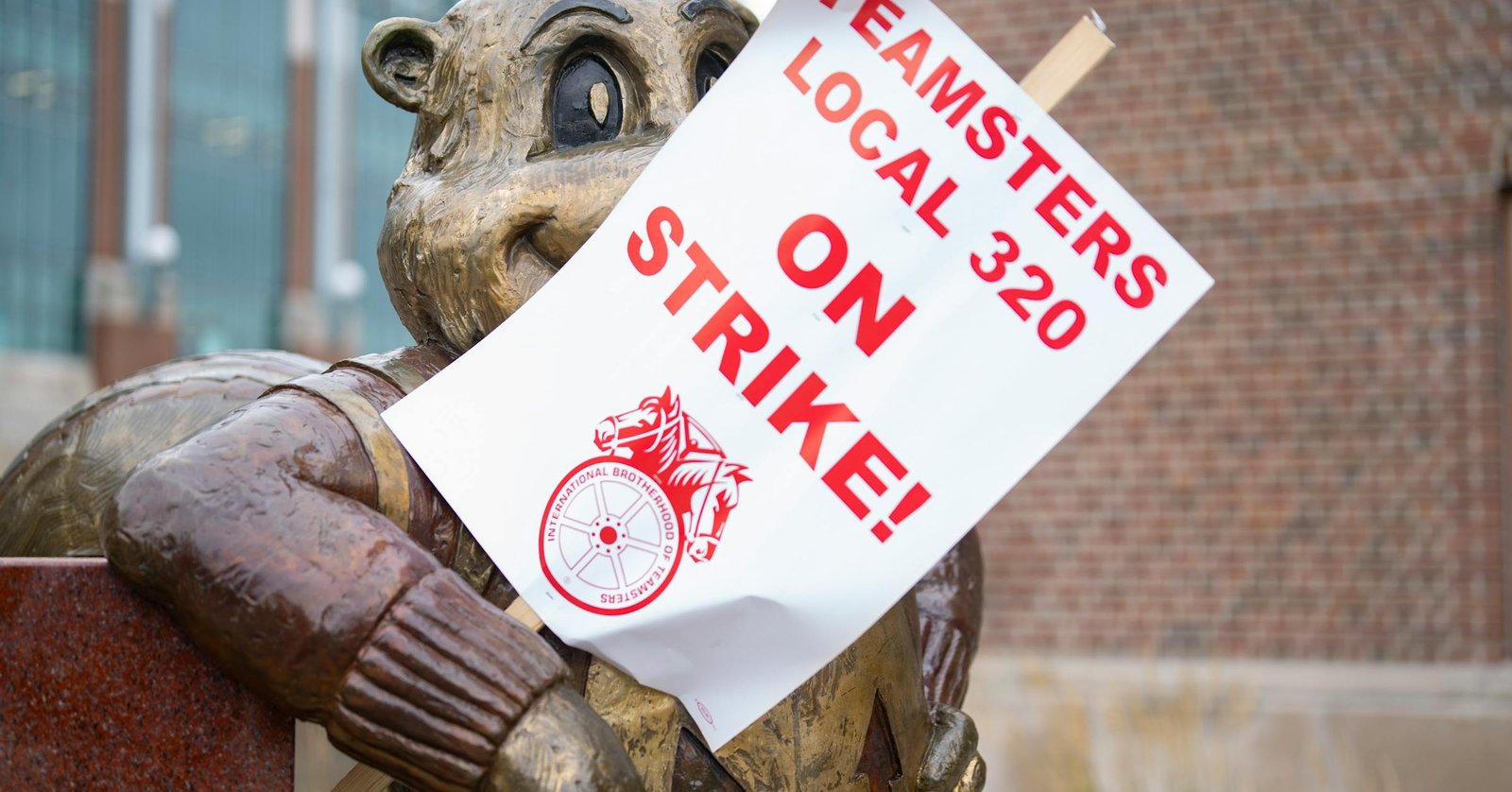Top Stories
Extraterrestrial life needs the right atmosphere. This planet 40 light-years away might fit the bill, scientists say

A rocky, Earth-size planet located in our Milky Way galaxy may have an atmosphere around it, according to new research, raising the possibility that it could also have liquid water on its surface and could therefore support life.
In two separate papers published Monday in the Astrophysical Journal Letters, astronomers zeroed in on the TRAPPIST-1 system, which consists of seven rocky planets that orbit a single star. Both studies outlined initial results from observations by NASA’s James Webb Space Telescope, suggesting that one planet in particular, known as TRAPPIST-1e, may have a nitrogen-rich atmosphere like Earth’s, though follow-up studies are needed to confirm the discovery.
The results are an important step in the ongoing search for extraterrestrial life in the solar system and beyond.
This week, NASA announced that a rock sample collected on Mars may contain evidence of ancient microbial life. Present-day Mars has a thin atmosphere mostly made up of carbon dioxide, nitrogen, and argon gases, but the Red Planet is thought to have had a thicker atmosphere billions of years ago, when liquid water flowed on its surface.
Scientists have long held that water is an essential ingredient for life.
To keep water in liquid form, rather than it evaporating instantly into space, a planet or moon needs to have an atmosphere. That makes the search for exoplanet atmospheres one of the most tantalizing in the field of astronomy.
“Ultimately, we want to get to the point where we find a planet, and huzzah, we see a molecule that can only be produced by life,” said Ryan MacDonald, an exoplanet astronomer at the University of St Andrews in Scotland and a co-author of both studies. “But you need to have an atmosphere, so what we’ve been working on first is to find planets that have atmospheres.”
The TRAPPIST-1 system, which is 40 light-years away from Earth, has been widely studied since it was discovered in 2016 because several of the planets could have conditions suitable to support extraterrestrial life.
Each light year is approximately 6 trillion miles.
TRAPPIST-1e, in particular, is thought to orbit its star in the theoretical “habitable zone,” a distance that is not too close for it to be hellishly hot, and not too far to be icy cold, but rather just right for liquid water to exist on the surface.
For the new studies, astronomers used NASA’s James Webb Space Telescope to observe four “transits” of TRAPPIST-1e, or times when the planet passed in front of its star. The telescope did not directly see an atmosphere around TRAPPIST-1e, but rather it measured how the exoplanet absorbed light to figure out what, if anything, surrounds the planet.
Much like a prism, light can be separated into different bands of color on a rainbow spectrum, and how certain colors are blocked or filtered can be telltale signatures of specific atoms or molecules of gas.
If certain colors are absorbed, for instance, it can suggest high concentrations of carbon dioxide. Other changes in color can hint at different chemical properties, including the presence of hydrogen, oxygen, methane or nitrogen.
“If we see no variation in color, then the planet is probably just a bare rock,” MacDonald said. “A bare rock doesn’t care if you shine red light or blue light on it. It will just block them all equally.”
In four transits, the researchers did not find evidence of a hydrogen-rich atmosphere around TRAPPIST-1e. Nor did they see signs that its potential atmosphere is dominated by carbon dioxide. The Webb telescope’s observations, however, do hint that its atmosphere could be rich in nitrogen.
“This is an exciting step and it really helps us narrow down the possibilities of an atmosphere that is perhaps more Earth-like,” said Caroline Piaulet-Ghorayeb, a postdoctoral fellow at the University of Chicago who was not involved with the new studies.
Earth’s own atmosphere contains high concentrations of nitrogen gas. Titan, one of the moons around Saturn, also has an atmosphere that is mostly nitrogen. NASA has said that Titan likely harbors a vast underground ocean, which could make it habitable, but the moon’s methane-filled environment would mean that any life that does exist there would be very different from life on Earth.
Piaulet-Ghorayeb separately was the lead author of a study published last month in The Astrophysical Journal that focused on a different planet in the TRAPPIST-1 system: TRAPPIST-1d, the third planet from the star that also orbits within the habitable zone. That study found no evidence of molecules that are common in Earth’s atmosphere, such as water, carbon dioxide or methane.
Studying these celestial bodies come with significant challenges.
The TRAPPIST-1 star is small but extremely active, which creates a lot of background noise for researchers to sift through. MacDonald and his colleagues, for instance, spent more than a year analyzing data from the Webb telescope and trying to differentiate chemical signatures coming from TRAPPIST-1e and its star.
To confirm the presence of an atmosphere, MacDonald and his colleagues are planning to study TRAPPIST-1e during 15 more transits in the coming years.
Studies are also forthcoming for three other planets that are farther out in the system, TRAPPIST-1f, TRAPPIST-1g and TRAPPIST-1h, he said.
The research should help scientists inch closer to answering some of the most enduring questions about exoplanets and the search for life.
“We haven’t yet convincingly found an atmosphere on any rocky planet outside of the solar system, which makes studying and searching for atmospheres on temperate planets extremely exciting,” Piaulet-Ghorayeb said. “But there’s a lot of work to do.”
Top Stories
Questions linger about alleged shooter’s motivation for killing Charlie Kirk | Charlie Kirk shooting

Though the suspect in the killing of conservative activist Charlie Kirk was revealed by authorities on Friday, questions surrounding his identity and motivations have exacerbated intense US political debates in the aftermath of the shooting.
Authorities revealed Kirk’s suspected killer to be Tyler Robinson, a 22-year-old man who grew up in Washington, Utah, along the state’s south-western border.
In absence of a clear motive for the slaying, reports have tried to piece together information about Robinson and his background. He is a third-year student in an electrical apprenticeship program at Dixie Technical College in the state. Both of his parents are registered Republicans, though his personal political beliefs remain unclear. Now-deleted pictures on social media show Robinson and his family posing with guns.
In an interview with the Wall Street Journal published on Saturday, Utah’s governor, Spencer Cox, said: “It’s very clear to us and to investigators that this was a person who was deeply indoctrinated with leftist ideology.” Cox cited the findings of the ongoing investigation into Robinson and his possible motive but did not provide any further details about how officials arrived at that conclusion.
Those remarks from Cox were published a day after he delivered a speech following Robinson’s arrest where he had a candid moment about Robinson’s identity as a Utahn.
“Bad stuff happens, and for 33 hours, I was praying that if this had to happen here, it wouldn’t be one of us,” Cox said. “That somebody drove from another state, somebody came from another country. Sadly, that prayer was not answered the way I hoped for.”
He went on to explain that it would have been “easier on us” if the suspect weren’t from the community.
“Just because I thought it would make it easier on us to say, ‘Hey, we don’t do that here.’ Indeed, Utah is a special place, we lead the nation in charitable giving, we lead the nation in service every year,” Cox said, tears welling in his eyes. “But it did happen here, and it was one of us.”
After Robinson’s identity was revealed, some conservatives have softened their attacks against Kirk’s alleged murderer as an individual – but continue to leverage anger toward liberals as a group.
Republican congresswoman Nancy Mace of South Carolina tweeted on Wednesday that “it’s time to bring back the death penalty” following Kirk’s murder.
On Friday, Mace said that Kirk “would want us to pray for such an evil and lost individual like Tyler Robinson to find Jesus Christ”.
“We will try to do the same,” she wrote.
She later doubled down on the death penalty, saying: “Some crimes are so evil, the only just punishment is the death penalty.” But, referring to the way the suspect’s father reportedly had a role in turning him over to authorities, she also said: “We are sending prayers and our high regards to Tyler Robinson’s father for doing the right thing.”
Cox’s speech has largely been praised as highlighting unity during a divisive moment, providing a stark contrast to Donald Trump, who considered Kirk a close ally. The president on Friday appeared on Fox & Friends and was asked by host Ainsley Earhardt, “How do we fix this country? How do we come back together?”
“The radicals on the right are radical because they don’t want to see crime,” Trump said. “The radicals on the left are the problem – and they are vicious and horrible and politically savvy. They want men in women’s sports, they want transgender people, they want open borders. The worst thing that happened to this country.”
after newsletter promotion
Conservatives had latched onto reports – that have since been retracted – that the casings for bullets found with the gun that police suspect was used to kill Kirk were engraved with markings indicating “trans ideology”.
“To the surprise of literally no one,” Megyn Kelly said on her show earlier in the aftermath of Kirk’s killing. “There’s one particular group that’s been running around killing Americans in the name of ideology, and it’s transgender activists or individuals, or those who proclaim that they are.”
Once Robinson’s identity was revealed, Kelly speculated that Robinson must have been radicalized after going to college.
“This kid got radicalized, and obviously had a psychotic break … I am disturbed to see that he appears to have come from a loving, intact family,” Kelly said. “If you look at the family social media profile, it looks like a happy family. It looks like a loving mom, and a loving dad. He had two younger brothers, there’s lots of family photos of them going on vacations and family dinners.”
Kelly noted that while authorities will be seeking the death penalty, it is ultimately a “mental health issue” that underpins the “radicalization” of young people who go to college.
Meanwhile, white nationalist Nick Fuentes sought to shut down speculation that Robinson may have been a “Groyper”, a nickname for a follower of Fuentes, after reports on the engravings on the bullets of the alleged killer’s gun led to theorizing on his ideology.
Groypers had long criticized Kirk and trolled speakers at his events because the former perceived the latter to be too politically moderate.
While Fuentes claimed in a social media post that he and his followers were “currently being framed for the murder of Charlie Kirk,” he also said in a streaming video: “I pray to God there is no further violence.”
“To all of my followers, if you take up arms, I disavow you,” Fuentes said. “I disown you in the strongest possible terms.”
Top Stories
Farm Aid on as University of Minnesota, Teamsters reach deal to end strike

Sources familiar with negotiations said Gov. Tim Walz’s office got involved late in the game to help reach a deal after Nelson’s call.
On Friday night, Nelson posted on X that he spoke to Walz and appreciated his involvement: “We both know that ultimately, it’s up to the university to do the right thing, and soon, so that Farm Aid 40 can go forward.”
In response, Gov. Walz posted on X around midnight: “We’ll get ‘er done, Willie.”
The university had not added new information to its strike update website and did not respond to requests for comment Saturday morning.
“I was happy to walk the picket line with the U of MN Teamsters. They deserve respect and fair wages for their work at the university,” Regent Robyn Gulley said Saturday, speaking as an individual Regent. “This strike is a lesson on the power of solidarity for working class families. Everyone should have a union.”
Top Stories
Trump says he’s ready to put ‘major sanctions’ on Russia if NATO nations do the same

President Donald Trump said Saturday he is “ready to do major Sanctions on Russia” once all NATO countries have started “to do the same thing” and pause their purchases of oil from Moscow.
He also urged NATO countries to impose “50% to 100% TARIFFS ON CHINA,” which he said should be withdrawn after the Russia-Ukraine war has concluded.
“China has a strong control, and even grip, over Russia, and these powerful Tariffs will break that grip,” Trump wrote in a Truth Social post, which he said was the text of a letter sent to all NATO nations and “the world.”
Trump has repeatedly threatened to impose sanctions on Russia over its invasion of Ukraine, but has so far held off from doing so.
Earlier this month, the president said he was prepared to move towards a second phase of sanctioning Russia, but has not yet imposed the levies.
Part of Trump’s reluctance to impose the strict economic punishments may be in part because he hopes he can broker a peace deal between Ukraine and Russia, analysts previously told CNBC.
“The second reason … is there is a sense that if Russia is defeated … then it has no choice but to go even further all-in with China, and that potentially then would strengthen China’s position,” Chris Weafer, the chief executive of Moscow-based Macro-Advisory, told CNBC earlier this month.
Trump’s Saturday post underscores that he is shifting his focus to NATO nations to put pressure on Russia to end its war.
“As you know, NATO’S commitment to WIN has been far less than 100%, and the purchase of Russian Oil, by some, has been shocking!” Trump wrote in the post.
“It greatly weakens your negotiating position, and bargaining power, over Russia,” he continued.
Hungary and Slovakia have continued to buy Russian fossil fuels, drawing criticism from Trump officials.
“We want to displace all Russian gas. President Trump, America, and all the nations of the EU, we want to end the Russian-Ukraine war,” U.S. Secretary of Energy Chris Wright said Friday.
-

 Business2 weeks ago
Business2 weeks agoThe Guardian view on Trump and the Fed: independence is no substitute for accountability | Editorial
-
Tools & Platforms1 month ago
Building Trust in Military AI Starts with Opening the Black Box – War on the Rocks
-

 Ethics & Policy2 months ago
Ethics & Policy2 months agoSDAIA Supports Saudi Arabia’s Leadership in Shaping Global AI Ethics, Policy, and Research – وكالة الأنباء السعودية
-

 Events & Conferences4 months ago
Events & Conferences4 months agoJourney to 1000 models: Scaling Instagram’s recommendation system
-

 Jobs & Careers2 months ago
Jobs & Careers2 months agoMumbai-based Perplexity Alternative Has 60k+ Users Without Funding
-

 Podcasts & Talks2 months ago
Podcasts & Talks2 months agoHappy 4th of July! 🎆 Made with Veo 3 in Gemini
-

 Education2 months ago
Education2 months agoVEX Robotics launches AI-powered classroom robotics system
-

 Education2 months ago
Education2 months agoMacron says UK and France have duty to tackle illegal migration ‘with humanity, solidarity and firmness’ – UK politics live | Politics
-

 Podcasts & Talks2 months ago
Podcasts & Talks2 months agoOpenAI 🤝 @teamganassi
-

 Funding & Business2 months ago
Funding & Business2 months agoKayak and Expedia race to build AI travel agents that turn social posts into itineraries

